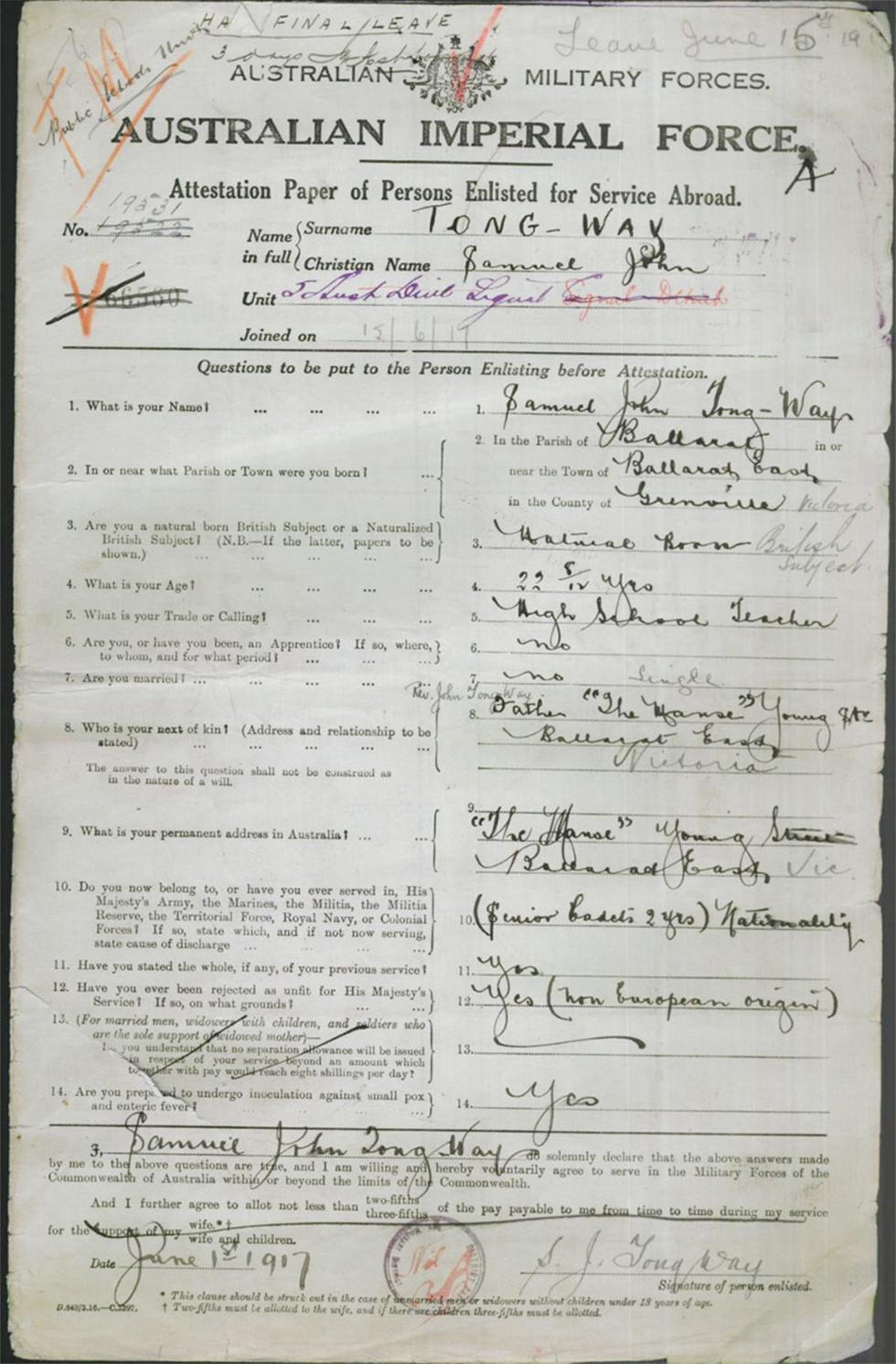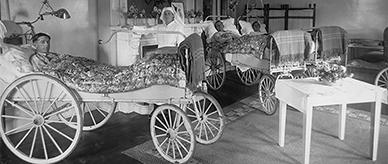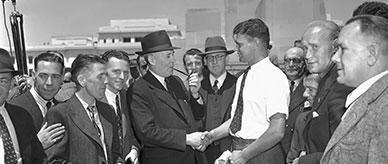


Transcript
[Handwritten notes around top of page, illegible.]
[Page header printed in black ink reads 'AUSTRALIAN [depiction of Australian coat of arms] MILITARY FORCES.']
AUSTRALIAN IMPERIAL FORCE. [underlined.]
Attestation Paper of Persons Enlisted for Service Abroad.
No. 19331 [number handwritten.] [19522, crossed out.]
Name in full
Surname[:] TONG-WAY [response handwritten]
Christian Name[:] Samuel John [response handwritten]
Unit[:] 5 Aust [Australian] Div Signal[.] Signal [crossed out] [illegible, crossed out] [response handwritten]
Joined on 15 / 6 / 17 [date handwritten.]
[Dividing line.]
Questions to be put to the Person Enlisting before Attestation.
[the following is presented in two columns, the questions on the left and responses on the right. All responses are handwritten.]
1. What is your name?
1. Samuel John Tong-Way
2. In or near what Parish or Town were you born?
2. In the Parish of Ballarat in or near the town of Ballarat East in the County of Grenville Victoria [Victoria written in pencil.]
3. Are you a natural born British Subject or a Naturalized British Subject? (N.B. – if the latter, papers to be shown.)
3. Natural Born[.] British Subject [British Subject written in pencil.]
4. What is your age?
4. 22 [illegible fraction] years
5. What is your Trade or Calling?
5. High School Teacher
6. Are you, or have you been an Apprentice? if so, where, to whom, and for what period:
6. no
7. Are you married?
7. no[.] single [single written in pencil]
8. Who is your next of kin? (address and relationship to be stated)
The answer to this question shall not be constructed as in the nature of a will.
8. Rev John Tong-Way. [written in pencil] Father "The House" Young Str [[street] Ballarat East Victoria [Victoria written in pencil]
9. What is your permanent address in Australia?
9. "The House" Young Str [Street] Ballarat East Vic [sic] [Vic written in pencil]
10. Do you now belong to, or have served in, His Majesty’s Army, the Marines, the Militia, the Militia Reserve, the Territorial Force, Royal Navy, or Colonial Forces? If so, state which, and if not now serving, state cause of discharge
10. (Senior Cadets 2yrs) Nationality
11. Have you stated the whole, if any of your previous service?
11. yes
12. Have you ever been rejected as unfit for His Majesty’s Service: if so, on what grounds?
12. Yes (non European Origin)
13. (For married men, widowers with children, and soldiers who are the sole support of widowed mother)- you understand that no separation allowance will be issued in respect of your service beyond an amount which together with pay would reach eight shillings per day? [question crossed out]
13. [response area crossed out.]
14. Are you prepared to undergo inoculation against small pox and enteric fever?
14. yes
[Dividing line.]
I, Samuel John Tong-Way [name handwritten] do solemnly declare that the above answers made by me to the above questions are true, and I am willing and hereby voluntarily agree to serve in the Military Forces of the Commonwealth of Australia within or beyond the limits of the Commonwealth.
And I further agree to allot not less than two-fifths [or] three-fifths of the pay payable to me from time to time during my service for the support for my wife [or] wife and children [footnotes denoted by asterisk and cross symbol.] [Section crossed out.]
Date[:] June 1st 1917 [date handwritten]
S.J. Tong Way [handwritten signature]
Signature of persons enlisted [italicised]
[stamp, illegible, handwritten initials, red ink in centre of stamp.]
[Footnotes:]
[asterisk] this clause should be struck out in the case of unmarried men or widowers without children under 18 years of age.
[cross] Two-fifths must be allotted to the wife, and if there are children three-fifths must be allotted.
About this record
This is Samuel John Tong Way's First World War Attestation Paper. In it he states that he is a ‘natural born British Subject’, which means he was born in Australia. When asked if he had ever been rejected as ‘unfit for His Majesty‘s Service’, he responded yes due to his 'non-European origin'.
Educational value
- Samuel John Tong Way and his brother Hedley David Tong Way served as sappers (engineers) in the 3rd Division Signal Company in the First World War (WW1). The signal companies provided communications from Army headquarters to subordinates through field telephones, radio, homing pigeons and motorcycle riders. As sappers, they were responsible for laying and repairing communications lines, among other tasks.
- Samuel and Hedley's first attempts to enlist in WW1 were both unsuccessful. Samuel was rejected due to his Chinese heritage, because the Defence Act 1909 specified that applicants 'not substantially of European origin or descent' were unable to enlist. Hedley was rejected due to poor vision. As the war continued, restrictions based on ethnicity were relaxed.
- Samuel and Hedley‘s parents, Mary Tong Way and the Reverend John Tong Way, migrated to Australia during the late 19th century. In 1921, they applied to be naturalised as British subjects but were rejected because it was Australian Government policy not to naturalise residents of Chinese origin. Under the Naturalization Act 1903, this restriction also applied to people born in Asia, Africa and the Pacific Islands (excluding New Zealand).
- During World War I and II, people who were not born in Australia and people who had not been naturalised were deemed ‘aliens’ by the Australian government. During wartime, for national security purposes, aliens had to register with the police or the military. In 1939, at the beginning of the Second World War, Mary Tong Way—despite having lived in Australia for 47 years, with two sons who had served in the First World War—had to register as an alien.
- It wasn’t until 1973 that the law changed so that migrants, regardless of their heritage, were able to obtain citizenship.
Related themes
Need help with your research?
Learn how to interpret primary sources, use our collection and more.


